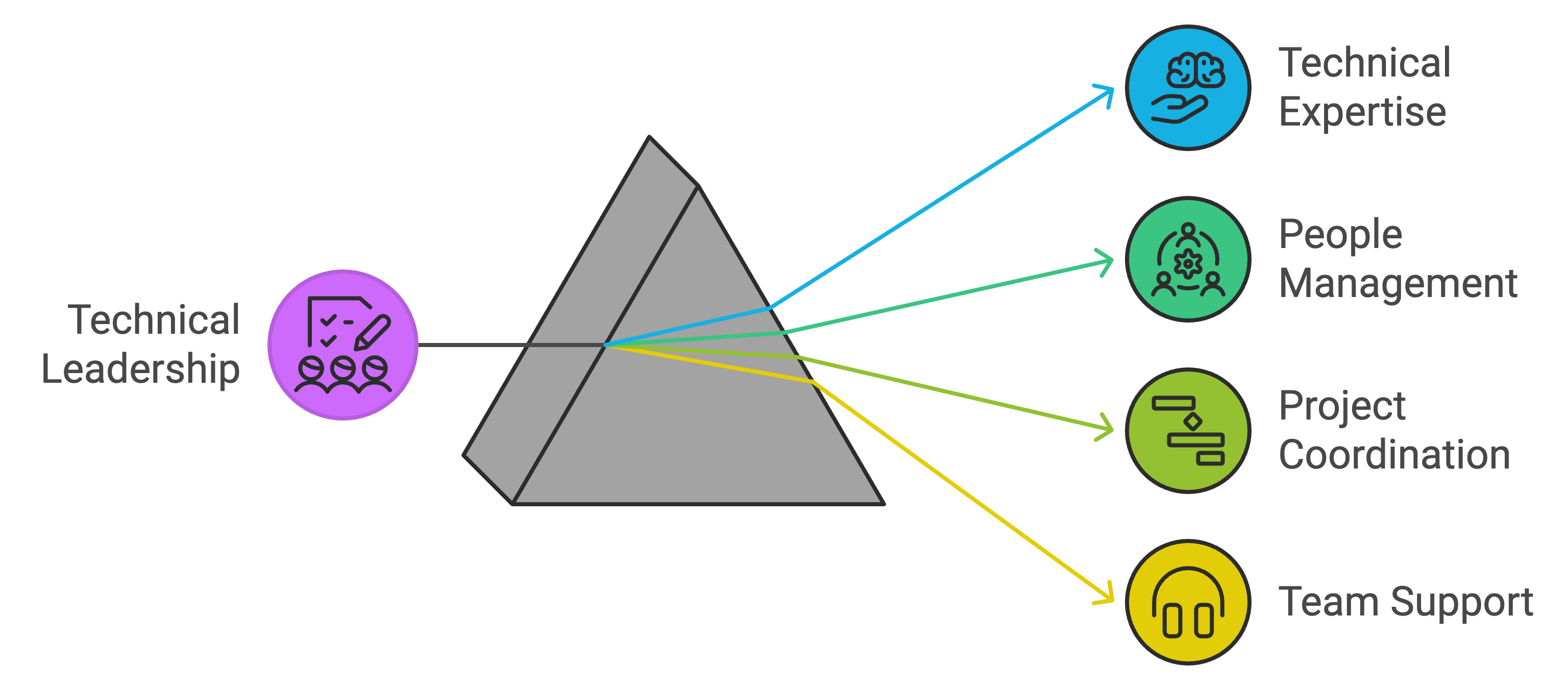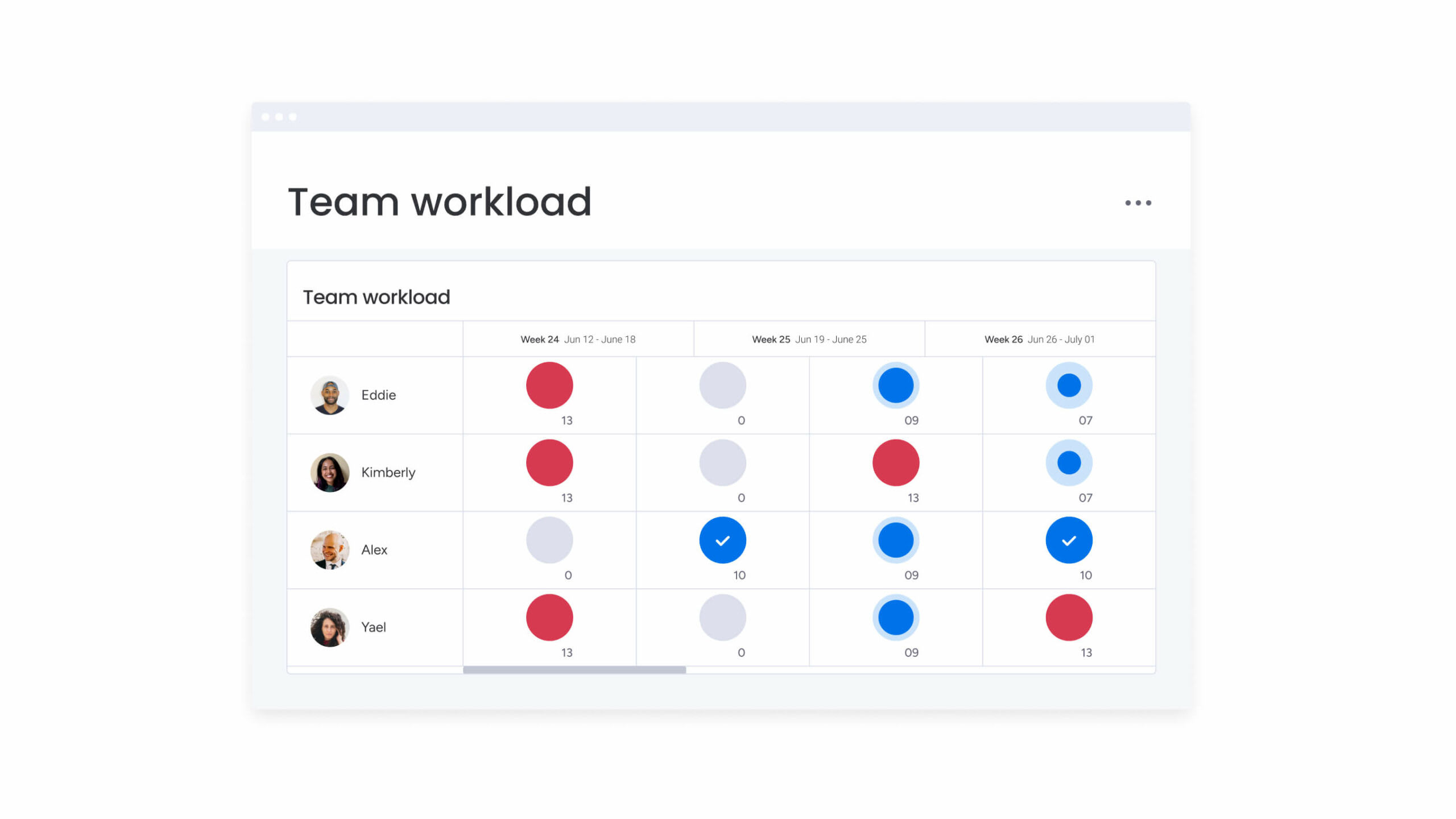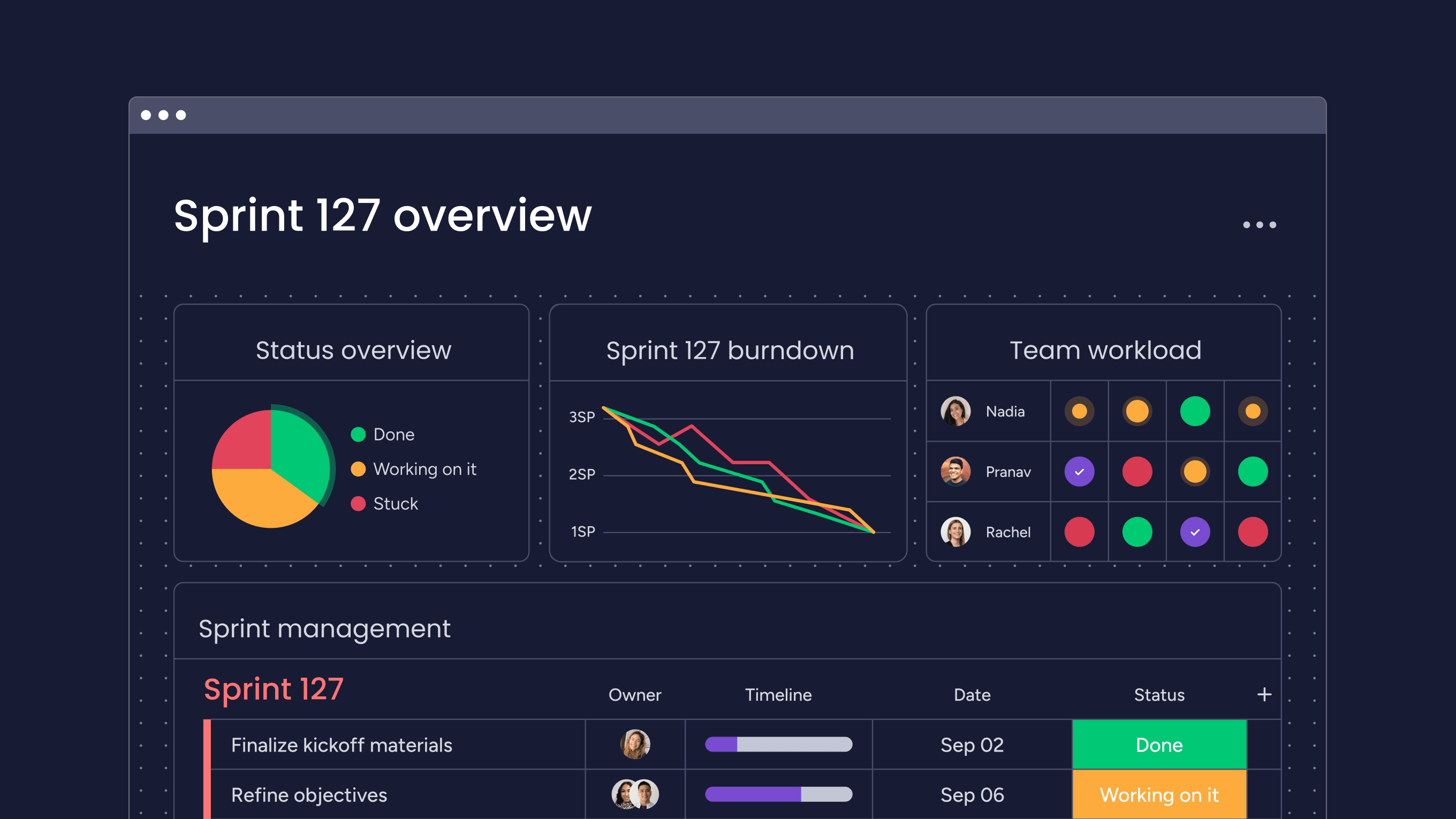Technical leaders wear many different hats: they’re the go-to person for technical problem solving, they ensure their team’s happiness and growth, and they deliver updates to management and stakeholders on development progress.
Technical leadership isn’t simple, but it can be very rewarding. By combining technical expertise with people management skills, tech leads can get the most out of their teams and help them, and by relation, their company, reach significant accomplishments.
This post will take a closer look at everything you need to know about technical leadership, from the skills required, responsibilities, tips, and tools that can help tech leads succeed, such as monday dev.
Try monday devWhat is technical leadership?

Technical leadership combines technical expertise and people management and refers to the responsibilities of the person supervising and guiding a development team. Technical leaders have strong skills in the technical field, allowing them to oversee a team of software engineers and ensure that development projects are reaching a company’s goals.
Tech leads are in charge of working with their teams to meet development objectives and coordinating projects from start to finish. They also help their team by providing technical solutions and insights while encouraging and inspiring employees to rise to personal and technical challenges and steer them in the right direction.
Key technical leadership skills
Having a background in engineering and software development is essential to be a strong technical leader, but it’s not the only skill you’ll need. There is a lot more that goes into leading a team of developers, including people management skills and problem-solving. Below, we’ll look at some of the technical and non-technical core skills a successful leader should have.
1. Coding and technical guidance
Leaders shouldn’t be reviewing every line of code, but they should conduct regular reviews and take on a coaching role for more junior team members. They’ll also need to act as a mentor and guide for their entire team, leading them through the reasoning behind certain decisions so that solutions are implemented correctly.
2. People and project management
As a technical leader, you’re not only responsible for the technical output but for the people behind the development as well, which requires a level of emotional intelligence and interpersonal skills. It’s crucial to have strong management skills to take responsibility for planning, executing, and managing projects, and also to have the understanding of how to manage a team with different levels of skills and experience.
3. Problem-solving skills
Technical leaders are the ones in charge of responding to problems, so when a crisis arises, whether with the development process or a personal matter with an employee, they need to act as the last line of defense. Critical thinking and taking a creative approach to problems are both essential traits to solving problems effectively.
4. Collaboration and communication skills
Tech leads need to reliably communicate company needs to their technical team and to non-technical stakeholders. They also need to be able to facilitate collaboration within their development team and with other departments to ensure seamless testing and implementation of products.
5. Mentorship and innovation
Technical leaders are the ones to push the needle within their team, helping each member not only complete their tasks but also help nurture them to grow to their full potential. It’s important for tech leads to provide ongoing feedback and build a culture of learning, where knowledge is gained through courses and also shared freely by initiatives between more experienced developers and newer team members so that the team is constantly striving to innovate.
Tech expertise vs. tech leadership: What’s the difference?
While they may sound similar, having technical expertise isn’t the same as being a technical leader. It’s true that tech expertise is an element of any technical leadership role, but individuals who don’t have some of the skills we covered above can still have a level of technical expertise.
In other words, they may not possess the management, problem-solving, or strategic traits needed to make high-level informed decisions and guide a team to success. A true technical leader will have all these traits along with a vast knowledge of technical subjects, making them fit to direct a team of developers.
The role and responsibilities of tech leads

Technical leadership involves a variety of different responsibilities. As we’ve seen from the vast range of skills tech leads require, the role of these managers is to steer their team towards success by directly supporting product development efforts. Here’s a closer look at specific responsibilities tech leads have:
- Determine realistic goals to drive project success through experience, setting KPIs, and considering the needs of the project and business
- Act as the go-to for high-level knowledge of systems, tools, architecture, and security measures
- Use their authority and judgment to make sure the team is working to implement solutions that fit a project’s parameters
- Rally the team around one specific goal and ensure each member works cohesively with the group to deliver high-quality solutions
- Ensures each team member has the skills and training needed to use their tech stack while continuously mentoring and offering performance feedback
- Coordinating information to provide direct reports to other leaders and upper management to report on project progress, successes, and failures
Tips for becoming a strong technical leader
Tech leads are generally more experienced individuals who have worked their way up to a managerial position. As a result, they often have a wealth of technical knowledge and experience managing others, making them a good fit for the demands of the job. Still, there are a few tips you can implement as a technical leader to ensure you’re getting the most out of your team.
Make sure your technical knowledge is unshakeable
In the role of tech lead, everyone from developers to management and stakeholders will be deferring to you for answers. Whether you need to explain complex topics in simple ways or help developers overcome problems, it’s critical to always stay on top of industry trends and the latest technologies in your industry.
Foster connections within your team
According to studies, 83% of developers experience burnout at work, making software development one of the roles most susceptible to burnout. It’s not uncommon for engineering teams to work overtime or feel overworked, so as a tech lead, it’s absolutely essential to foster strong connections with your team and within your team. Employees who feel connected to their teammates can rely on them more for moral support and will feel more open to approaching their team lead if they’re unhappy with work.
Inspire a habit of learning
Along with making your team feel comfortable on a personal level, you always want to encourage them to invest in their technical knowledge by upskilling, testing new programs, and learning from each other. As a tech lead, it’s your job to inspire creativity, exploration, and a culture of continuous learning, which you should lead by example.
Focus on creating a positive working environment
Make it enjoyable for your team to come to work by eliminating technical and non-technical roadblocks from their day-to-day. As their leader, you should always be open and transparent about goals and expectations while continuously motivating team members by providing constructive feedback and positive reinforcement when it’s due.
Implement the right tools for managing your team
One of the best ways to keep track of your team’s performance and help them succeed is to use the right software tools for your job. Aside from programming platforms, you should also have a solution for seamless communication, project and bug tracking, task tracking, product management, and collaboration. That said, you also don’t want to overwhelm your team with an excessive amount of tools, so opting for an all-in-one development platform like monday dev will help you streamline all your tasks and communication while tracking team and project progress.
Try monday devStrong tech leads need strong tech tools like monday dev
monday dev is a customizable platform that helps your engineering team navigate multiple aspects of development, from strategy to launch. By unifying efforts around one core platform, teams can communicate more efficiently and keep track of their assigned tasks so that nothing falls through the cracks.
For tech leads, knowing that everything is organized in one place makes it easier to monitor project progress, group performance, and project budgets and timelines. Below, we’ll take a look at a few key features that make monday dev an indispensable tool for tech leads.
Multiple work views including workload management

With monday dev, you can view your work your way with over 27 different work views, including Gantt, Kanban, Timeline, Calendar, and more. There’s also a Workload view so you can visualize how much work is on each team member’s desk, helping them avoid being overworked and getting burned out.
Integrations with the tools you use

monday dev can easily integrate with over 200 of the most popular work tools and apps. With integrations for tools like GitHub, GitLab, Figma, and hundreds more, you can make sure that data, automations, and tasks can flow easily between your different programs.
Templates for everything from bug tracking to sprint management

Get access to hundreds of customizable templates for R&D teams, to make getting started on new projects and tasks quick and easy. There are templates for user story templates, building roadmaps, tracking bugs, managing sprints, retrospectives, and many more.
High-level insights from custom dashboards

With monday dev, you can customize your own dashboards so you can have a bird’s eye view over project progress. These dashboards make it clear for leadership to view essential data at a glance, like workload distribution, deadlines, progress towards goals, and more, so that technical decisions can be made based on real-time data.
Try monday devImprove your technical leadership with the right tools
While there are technical and management skills that are crucial to technical leadership, tech leads can always make things easier on themselves by using the right tips and tools to effectively manage their team. With a platform like monday dev, tech leads can make sure their team and projects are on the right track, making it easier to focus more of their energy on mentoring team members and inspiring innovation and creativity.
FAQs
What is the meaning of technical leadership?
Technical leadership is a role in which a person with deep technical knowledge guides and manages a technical team, such as software developers. Technical leaders are not only technical experts but also possess people management skills that make them a good fit for this type of role.
What are the qualities of a technical leader?
What are the qualities of a technical leader?
Technical leaders require a wide range of skills, from technical know-how to soft skills as well as management skills. Some of the key qualities of a technical leader include people management, communication, technical expertise, problem-solving, critical thinking, mentoring, and others.
What is the difference between people leadership and technical leadership?
Technical leadership requires a lot of knowledge in a specific field, such as software development. Not everyone with deep technical knowledge has leadership ability where they know how to manage a team of people and vice versa, so it’s essential for strong technical leaders to display both people and technical leadership.
 Get started
Get started 
